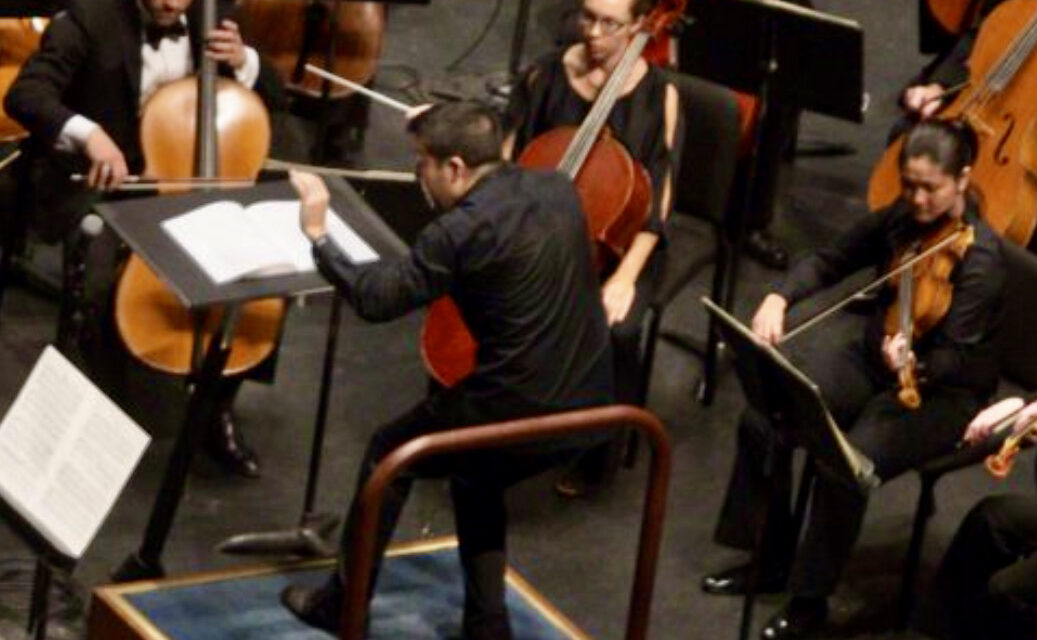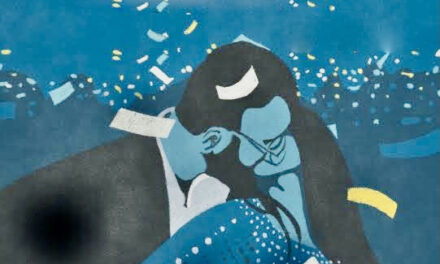(Above: Conductor Francesco Lecce-Chong in an earlier season of the Eugene Symphony.)
By Daniel Buckwalter
(#CommonManAtTheSymphony)
Soulful prayers, jagged and stormy anger, the bewilderment of it all, followed by the elegant voice of simple faith and, finally, ascension to heaven.
Gustav Mahler’s Symphony No. 2, Resurrection, has it all, and its full-throated intensity was absorbed and appreciated by a near-packed house at the Hult Center’s Silva Concert Hall on May 23. Its performance by the Eugene Symphony Orchestra, along with the Eugene Symphony Chorus and vocal soloists soprano Nina Warren and mezzo-soprano Ola Rafalo, made for a dazzling show.
As season finales go — not to mention the final performance of Francesco Lecce-Chong as the symphony’s artistic director — it was a grand spectacle.
The program began peacefully enough with the chorus engaging the audience in three short choral responses composed by Amy Cheney-Beach, based on Biblical scripture from the gospels of Luke and John as well as the book of Philippians. All three pieces sound a plea for forgiveness and provide comfort for the dying.
It is near the end of the third piece from the Gospel of John (“Peace I Leave With You”) that you know the tenderness of the program’s start will soon give way to the hailstorm that is Mahler’s perception of death. Bows are up for all string players as the chorus sings, “Let not your heart be troubled / Let not your heart / your heart be troubled,” and then the madness begins.
The first movement of the Resurrection symphony can be seen as a funeral, and it is chilling. Cellos and basses growl with fervor in the belly of dejection, expressing anger toward death while violins answer with shrieks of bitterness. It’s almost violent.
Back and forth this goes throughout the movement, with added crashes of percussion and brass. The first movement is perhaps the greatest piece of work to capture the acute and immediate storm that is on the minds of survivors in the days and weeks after a death. It can be crushing.
Musicologists have noted that Mahler deliberately put in a five-minute break between the first and second movements. Conductors have played with that over the years, and Lecce-Chong decided to make the end of the first movement the intermission period.
It was just as well. I, for one, needed some air after the first movement.
The second movement is a more joyful affair. Pleasant memories of the deceased start to pop up, and smiles come to those who are mourning.
Mahler touches well on one aspect of mourning the deceased that is often overlooked — the absurdity of listening and attending to the everyday and mundane matters of life immediately after the death of a loved one. No one cares about bills or work chores while they are in mourning. There must be deeper meaning to life.
In the third movement, Mahler notes the legend of St. Anthony of Padua, the well-known Franciscan preacher and teacher of the 12th century, as well as the patron saint of lost or stolen articles. Mahler does this in a poem satirizing St. Anthony preaching to fish in the river.
The fish symbolize a congregation that listens attentively, but upon completion of the service, returns to daily life without having taken to heart the priest’s spiritual message. Anthony, too, emerges as an ironical figure, since he seems perfectly content to deliver his sermon to a flock that cannot understand him.
The fourth movement is a simple and heartfelt declaration of faith as well as a longing for a spiritual union with God. The healing — or, perhaps, acceptance of loss — is underway, and it leads to the stirring and triumphant fifth movement, the ascension. “To bloom again, you are sown,” the chorus sings.
Mahler’s Resurrection Symphony is a physically taxing piece, especially for the orchestra, yet it was performed magnificently by the Eugene Symphony, its chorus and the soloists.
Truly, it was a treat to hear, and it was a wonderful and approprate send-off for Lecce-Chong as he ends his role as the Eugene Symphony Orchestra’s artistic director, which he began during the 2017-18 season.












